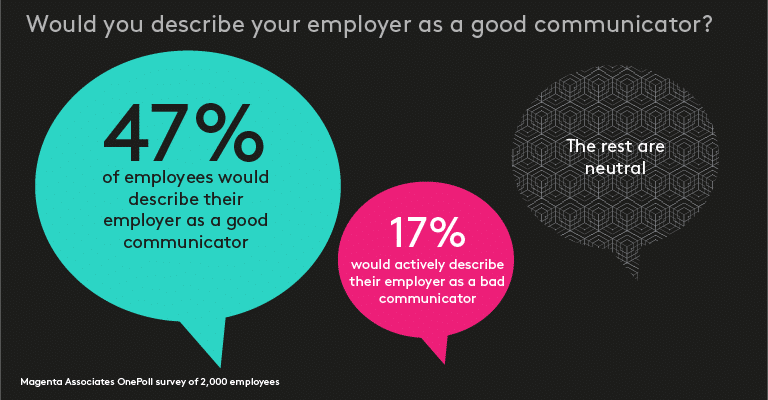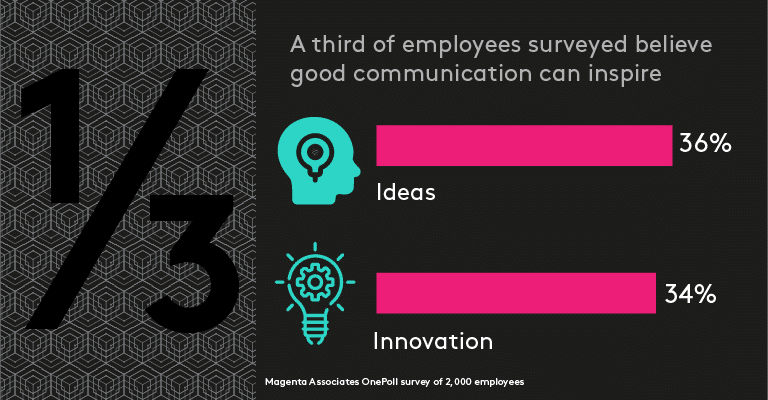Business-to-employee communications is essential to keep staff happy, engaged and productive.
What is business-to-employee communications?
Business-to-employee (B2E) communications is how a company communicates with its employees. It can also be referred to as internal communications. A B2E communications strategy is essential as it will ensure employees are happy, informed, motivated and loyal to the business.
Most companies have strategies in place for business-to-business (B2B) and business-to-consumer (B2C) communications. Very few have a B2E communications strategy.
Many companies don’t have a designated member of staff who is responsible for B2E comms. It can often fall to departments such as HR and marketing, which results in mixed messaging and confusion.
A comprehensive B2E comms strategy should comprise key messages to share with employees, who is responsible, and the tools used to share messages. The latter can include email, texts, phone calls, Intranet, social media and internal newsletters

B2E report
Words matter. Precision matters. Shared ideas matter. Engagement matters. And they especially matter when it comes to communicating change to an increasingly diverse and dispersed workforce.
That is why so many organisations are now placing so much emphasis on their
internal communications.
Download our B2E white paper Internal communications: The glue that holds everything together
Internal communication is vital for the culture, wellbeing and strength of an organisation.
The key content areas of B2E comms

Talent attraction and retention
How you talk to your employees will have a big impact on talent attraction and retention. Employees that receive clear, regular communications will develop a better connection with the company. Areas to consider include:
- Company value proposition
- Leadership communications
- Recruitment messaging
- Onboarding
- Learning and development
- Career progression
Reward and recognition
Employees want to be rewarded and recognised for their hard work. You might have some of the best perks around, but if you don’t clearly communicate them, your employees won’t know or appreciate what you have to offer. Areas to consider include:
- Recognition schemes
- Benefits, from office snacks to flexible work policies
- Retirement schemes and pensions
- Bonuses, shares and incentives
- Year-end communications

to discuss how Magenta can help you.
For 10 years, Magenta has been the communication expert in the built environment. We have helped organisations of all sizes communicate with their target audiences, whether that be prospective customers in the wider market or people within their own buildings.
Download our business-to-employee communications case study book for more background on our work.

One third of businesses we surveyed do not have the in-house support required for their B2E strategy.

Brand and corporate culture
The office is a great way to share corporate culture. However, the rise of hybrid working means that many employees will now be in the physical workplace less often; being able to effectively share brand values to remote workers is more important than ever. Areas to consider include:
- Aligning the employee value proposition with the company purpose
- Corporate narrative and tone of voice
- Strategy and vision
- Brand guidelines
- HR strategies
- Employee surveys
Change communication
The pandemic saw a seismic shift in how we work, but in truth workplaces are always evolving. This could range from an office redesign to a change in company operations. Communicate with your employees at all times to keep them engaged in the process. Areas to consider include:
- Transformational or strategic change
- Operational change
- Behavioural change
- Technological change
- Cultural change

The pandemic has changed employee business-to-employee communications
Magenta noticed there’s been a shift in business communications priorities in the wake of the pandemic and we wanted to find out whether our experience reflects what’s going on more widely.
We conducted a survey with 2,000 employees to explore how they rate their employers communication. The results speak for themselves. We’ve also canvassed the views of business leaders – those ‘in the know’ – about how employers can effectively communicate with employees to offer tips when it comes to communicating workplace change, whatever that may look like.

to discuss how Magenta can help you.
Magenta offers expert communications support
We are specialists in the workplace and have supported numerous clients with urgent employee communications at the height of the pandemic. We have unrivalled B2E knowledge, creative solutions, and a team with deep expertise in communications strategies.
At a time when businesses are in a battle to attract and retain the best talent, how you communicate with employees can be a crucial differentiator.
Latest Case Studies

Case study: Kam Singh and EMCOR UK
Our client EMCOR UK sought to further strengthen awareness of its position as a leader in sustainable carbon management. Central to this effort was ESG

Internal comms case study: Unravelling what employees really think
One of our facilities management clients with multiple service lines and dispersed teams was concerned that some employees may not feel part of the company’s

University of Sussex case study: building a procurement blueprint
In advance of the University of Sussex’s first-generation outsourcing programme for its facilities management and catering, conferencing and banqueting services, Magenta was commissioned to run
Latest News & Views

Transforming internal communications at Corps Security
With a workforce exceeding 3,500 employees across various roles and locations, Corps Security identified a critical gap in its internal communications. Many employees were struggling

How to make the most of your event sponsorship
So, you’ve invested in sponsoring an event or securing a stand at a key industry gathering. Great move! But now comes the tricky part –

5 important steps for communicating your organisation’s RTO policy
Workplace change happens for all sorts of reasons. Often, organisations are relocating to new premises, merging companies after an acquisition, undergoing a business-wide digital transformation,








